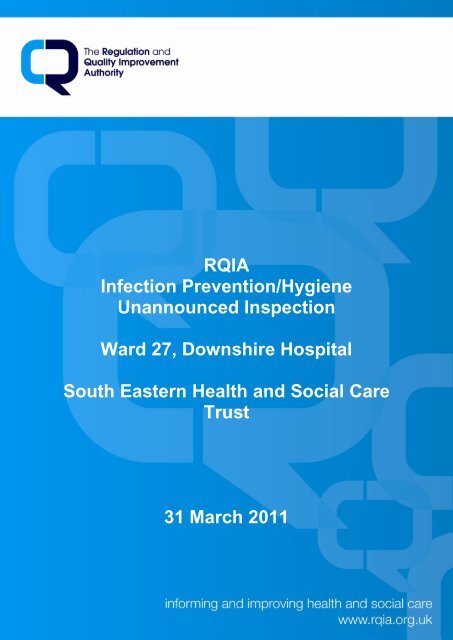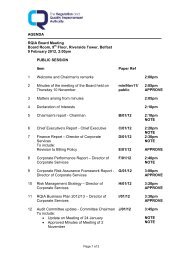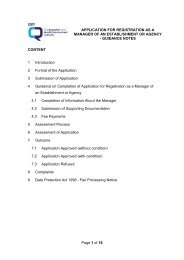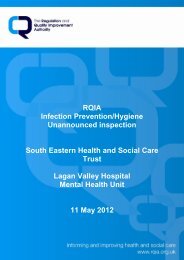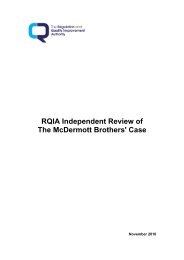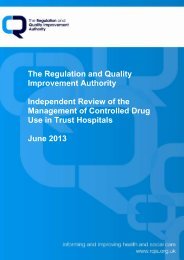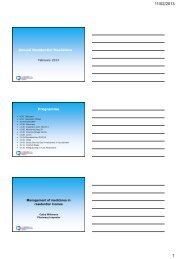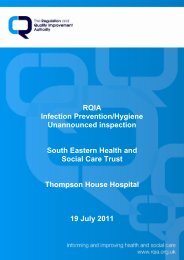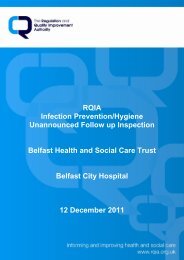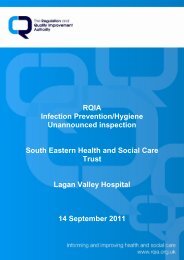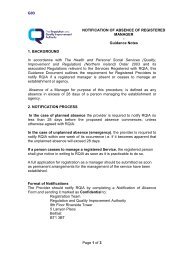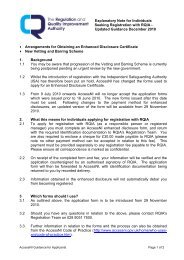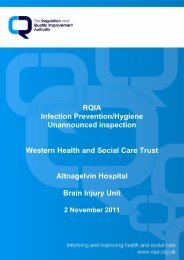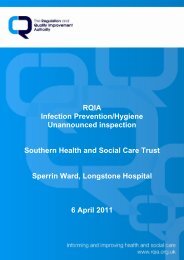Downshire Hospital, Downpatrick - Regulation and Quality ...
Downshire Hospital, Downpatrick - Regulation and Quality ...
Downshire Hospital, Downpatrick - Regulation and Quality ...
You also want an ePaper? Increase the reach of your titles
YUMPU automatically turns print PDFs into web optimized ePapers that Google loves.
RQIA<br />
Infection Prevention/Hygiene<br />
Unannounced Inspection<br />
Ward 27, <strong>Downshire</strong> <strong>Hospital</strong><br />
South Eastern Health <strong>and</strong> Social Care<br />
Trust<br />
31 March 2011<br />
[Type text]
Contents<br />
1.0 Inspection Summary 1<br />
2.0 Background Information to the Inspection Process 5<br />
3.0 Inspections 6<br />
4.0 Unannounced Inspection Process 7<br />
4.1 Onsite Inspection 7<br />
4.2 Feedback <strong>and</strong> Report of the findings 7<br />
5.0 Audit Tool 8<br />
6.0 Environment 10<br />
6.1 Cleaning 10<br />
6.2 Clutter 11<br />
6.3 Maintenance <strong>and</strong> Repair 11<br />
6.4 Fixture <strong>and</strong> Fittings 12<br />
6.5 Information 13<br />
7.0 Patient Linen 14<br />
7.1 Management of Linen 14<br />
8.0 Waste <strong>and</strong> Sharps 15<br />
8.1 Waste 15<br />
8.2 Sharps 15<br />
9.0 Patient Equipment 17<br />
10.0 Hygiene Factors 18<br />
11.0 Hygiene Practice 19<br />
12.0 Key Personnel <strong>and</strong> Information 21<br />
13.0 Summary of Recommendations 22<br />
14.0 Unannounced Inspection Flowchart 24<br />
15.0 RQIA Hygiene Team Escalation Policy Flowchart 25<br />
16.0 Action Plan 26
1.0 Inspection Summary<br />
An unannounced inspection was undertaken to <strong>Downshire</strong> <strong>Hospital</strong>,<br />
on the 31 March 2011. The hospital was assessed against the draft<br />
Regional Healthcare Hygiene <strong>and</strong> Cleanliness st<strong>and</strong>ards <strong>and</strong> the<br />
following area was inspected:<br />
Ward 27<br />
Ward 27 is a mixed gender ward on the ground floor of the Dixon<br />
Block, <strong>Downshire</strong> <strong>Hospital</strong>. The ward is one of the three remaining<br />
inpatient facilities on this site <strong>and</strong> provides four Psychiatric Intensive<br />
Care Unit (PICU) beds <strong>and</strong> 12 continuing care beds for adult mental<br />
health patients.<br />
The acting Ward Manager advised inspectors that the South Eastern<br />
Health <strong>and</strong> Social Care Trust (SEHSCT) aims to close this ward as part<br />
of plans to update mental health services. It is planned that the PICU<br />
will move to the acute admission ward in Lagan Valley <strong>Hospital</strong> <strong>and</strong> the<br />
remaining beds to the Downe <strong>Hospital</strong>. This is proposed to happen<br />
over the next 18 - 24 months.<br />
There is a wide entrance to the ward with a seating area for the<br />
patients along the corridor. There is also a communal dining area <strong>and</strong><br />
day room which includes a conservatory looking onto an enclosed<br />
garden, which requires supervised access <strong>and</strong> can only be accessed at<br />
the discretion of nursing staff. The ward has a visitor’s room, a<br />
seclusion room <strong>and</strong> an isolation room. Other facilities on the ward<br />
include: a laundry room <strong>and</strong> a range of toilet <strong>and</strong> bathroom facilities<br />
<strong>and</strong> store rooms.<br />
Patients are mainly accommodated in four bedded bays; these are<br />
segregated into male <strong>and</strong> female areas. There are four single rooms,<br />
one of which is for admission purposes <strong>and</strong> a night duty nursing area to<br />
facilitate patient observation. The Occupational Therapy (OT) activity<br />
room is situated on this part of the ward.<br />
The ward currently has an Acting Manager <strong>and</strong> at the time of<br />
inspection there was a total of 15 patients.<br />
The inspection resulted in 14 recommendations for the SEHSCT <strong>and</strong><br />
<strong>Downshire</strong> <strong>Hospital</strong>, a full list of recommendations is listed in Section<br />
13.<br />
A detailed list of preliminary findings is forwarded to SEHSCT within 14<br />
days of the inspection to enable early action on identified areas which<br />
have achieved non complaint scores. The draft report which includes<br />
the high level recommendations in a <strong>Quality</strong> Improvement Plan is<br />
forwarded within 28 days of the inspection for agreement <strong>and</strong> factual<br />
accuracy. The draft report is agreed <strong>and</strong> a completed action plan is<br />
1
eturned to RQIA within 14 days from the date of issue. The detailed<br />
list of preliminary findings is available from RQIA on request.<br />
The final report <strong>and</strong> <strong>Quality</strong> Improvement Plan will be available on the<br />
RQIA website. Reports <strong>and</strong> action plans will be subject to performance<br />
management by the Health <strong>and</strong> Social Care Board <strong>and</strong> the Public<br />
Health Agency.<br />
Notable Practice<br />
The inspection identified the following areas of notable practice:<br />
H<strong>and</strong> hygiene audits are carried out<br />
Environmental cleanliness audits are carried out<br />
The acting ward manager has devised a well defined colour<br />
coded training matrix<br />
Weekly maintenance checks of the ward are in place<br />
The ward has a link nurse who staff refer to for all IPC<br />
concerns<br />
The RQIA inspection team would like to thank the staff at the<br />
<strong>Downshire</strong> <strong>Hospital</strong> for their assistance during the inspection.<br />
The following tables give an overview of compliance scores noted in<br />
areas inspected by RQIA:<br />
Table 1 summarises the overall compliance levels achieved.<br />
Tables 2-7 summarise the individual tables for sections two to seven of<br />
the audit tool as this assists organisation to target areas that require<br />
more specific attention.<br />
Table 1<br />
Areas Inspected Ward 27<br />
General Environment 76<br />
Patient Linen 85<br />
Waste 87<br />
Sharps 86<br />
Equipment 88<br />
Hygiene Factors 99<br />
Hygiene Practices 96<br />
Average Score 88<br />
Compliant:<br />
85% or above<br />
Partial Compliance: 76% to 84%<br />
Minimal Compliance: 75% or below<br />
2
Table 2<br />
General Environment Ward 27<br />
Reception 53<br />
Corridors, stairs lift<br />
N/A<br />
Public toilets 70<br />
Ward/department –<br />
general (communal)<br />
79<br />
Patient bed area 70<br />
Bathroom/washroom 76<br />
Toilet 68<br />
Clinical room/treatment<br />
room<br />
88<br />
Clean utility room<br />
N/A<br />
Dirty utility room 64<br />
Domestic store 84<br />
Kitchen 77<br />
Equipment store<br />
N/A<br />
Isolation 87<br />
General information 96<br />
Average Score 76<br />
Table 3<br />
Patient Linen Ward 27<br />
Storage of clean linen 83<br />
Storage of used linen 100<br />
Laundry facilities 71<br />
Average Score 85<br />
Table 4<br />
Waste <strong>and</strong> Sharps Ward 27<br />
H<strong>and</strong>ling, segregation,<br />
storage, waste<br />
87<br />
Availability, use, storage of<br />
sharps<br />
86<br />
Table 5<br />
Patient Equipment Ward 27<br />
Patient equipment 88<br />
Compliant:<br />
85% or above<br />
Partial Compliance: 76% to 84%<br />
Minimal Compliance: 75% or below<br />
3
Table 6<br />
Hygiene Factors Ward 27<br />
Availability <strong>and</strong> cleanliness<br />
of wash h<strong>and</strong> basin <strong>and</strong><br />
94<br />
consumables<br />
Availability of alcohol rub 100<br />
Availability of PPE 100<br />
Materials <strong>and</strong> equipment<br />
for cleaning<br />
100<br />
Average Score 99<br />
Table 7<br />
Hygiene Practices Ward 27<br />
Effective h<strong>and</strong> hygiene<br />
procedures<br />
100<br />
Safe h<strong>and</strong>ling <strong>and</strong> disposal<br />
of sharps<br />
100<br />
Effective use of PPE 100<br />
Correct use of isolation 100<br />
Effective cleaning of ward 80<br />
Staff uniform <strong>and</strong> work<br />
wear<br />
93<br />
Average Score 96<br />
Compliant:<br />
85% or above<br />
Partial Compliance: 76% to 84%<br />
Minimal Compliance: 75% or below<br />
4
2.0 Background Information to the Inspection Process<br />
RQIA’s infection prevention <strong>and</strong> hygiene team was established to<br />
undertake a rolling programme of unannounced inspections of acute<br />
hospitals. The Department of Health Social Service <strong>and</strong> Public Safety<br />
(DHSSPS) commitment to a programme of hygiene inspections was<br />
reaffirmed through the launch in 2010 of the revised <strong>and</strong> updated<br />
version of 'Changing the Culture' the strategic regional action plan for<br />
the prevention <strong>and</strong> control of healthcare-associated infections (HCAIs)<br />
in Northern Irel<strong>and</strong>.<br />
The aims of the inspection process are:<br />
to provide public assurance <strong>and</strong> to promote public trust <strong>and</strong><br />
confidence<br />
to contribute to the prevention <strong>and</strong> control of HCAI<br />
to contribute to improvement in hygiene, cleanliness <strong>and</strong> infection<br />
prevention <strong>and</strong> control across health <strong>and</strong> social care in Northern<br />
Irel<strong>and</strong><br />
In keeping with the aims of the RQIA, the team will adopt an open <strong>and</strong><br />
transparent method for inspection, using st<strong>and</strong>ardised processes <strong>and</strong><br />
documentation.<br />
5
3.0 Inspections<br />
The DHSSPS has devised draft Regional Healthcare Hygiene <strong>and</strong><br />
Cleanliness st<strong>and</strong>ards. RQIA has revised its inspection processes to<br />
support the publication of the st<strong>and</strong>ards which were compiled by a<br />
regional steering group in consultation with service providers.<br />
RQIA's infection prevention/hygiene team have planned a three year<br />
programme which includes announced <strong>and</strong> unannounced inspections<br />
in acute <strong>and</strong> non-acute hospitals in Northern Irel<strong>and</strong>. This will assess<br />
compliance with the DHSSPS Regional Healthcare Hygiene <strong>and</strong><br />
Cleanliness st<strong>and</strong>ards.<br />
The inspections will be undertaken in accordance with the four core<br />
activities outlined in the RQIA Corporate Strategy, these include:<br />
Improving care: we encourage <strong>and</strong> promote improvements in the<br />
safety <strong>and</strong> quality of services through the regulation <strong>and</strong> review of<br />
health <strong>and</strong> social care<br />
Informing the population: we publicly report on the safety,<br />
quality <strong>and</strong> availability of health <strong>and</strong> social care<br />
Safeguarding rights: we act to protect the rights of all people<br />
using health <strong>and</strong> social care services<br />
Influencing policy: we influence policy <strong>and</strong> st<strong>and</strong>ards in health<br />
<strong>and</strong> social care<br />
6
4.0 Unannounced Inspection Process<br />
Trusts receive no advanced notice of the onsite inspection. An email<br />
<strong>and</strong> telephone call will be made by the Chief Executive of RQIA or<br />
nominated person 30 minutes prior to the team arriving on site. The<br />
inspection flow chart is attached in Section 14.<br />
4.1 Onsite Inspection<br />
The inspection team was made up of two inspectors, from RQIA’s<br />
infection prevention/hygiene team. One inspector led the team <strong>and</strong><br />
was responsible for guiding the team <strong>and</strong> ensuring they were in<br />
agreement about the findings reached. Membership of the inspection<br />
team is outlined in Section 12.<br />
The inspection of ward environments is carried out using the draft<br />
Regional Healthcare Hygiene <strong>and</strong> Cleanliness audit tool. The<br />
inspection process involves observation, discussion with staff, <strong>and</strong><br />
review of some ward documentation.<br />
4.2 Feedback <strong>and</strong> Report of the Findings<br />
The process concludes with a feedback of key findings to trust<br />
representatives including examples of notable practice identified during<br />
the inspection. The details of trust representatives attending the<br />
feedback session is outlined in Section 12.<br />
The findings, report <strong>and</strong> follow up action will be in accordance with the<br />
Infection Prevention/ Hygiene Inspection Process (methodology, follow<br />
up <strong>and</strong> reporting).<br />
The infection prevention/hygiene team escalation process will be<br />
followed if inspectors/reviewers identify any serious concerns during<br />
the inspection (Section 15).<br />
A number of documents have been developed to support <strong>and</strong> explain<br />
the inspection process. This information is currently available on<br />
request <strong>and</strong> will be available in due course on the RQIA website.<br />
7
5.0 Audit Tool<br />
The audit tool used for the inspection is based on the draft Regional<br />
Healthcare Hygiene <strong>and</strong> Cleanliness st<strong>and</strong>ards. The st<strong>and</strong>ards<br />
incorporate the critical areas which were identified through a review of<br />
existing st<strong>and</strong>ards, guidance <strong>and</strong> audit tools (Appendix 2 of Regional<br />
Healthcare Hygiene <strong>and</strong> Cleanliness st<strong>and</strong>ards). The audit tool follows<br />
the format of the draft Regional Healthcare Hygiene <strong>and</strong> Cleanliness<br />
St<strong>and</strong>ards <strong>and</strong> comprises of the following sections.<br />
1. Organisational Systems <strong>and</strong> Governance: policies <strong>and</strong><br />
procedures in relation to key hygiene <strong>and</strong> cleanliness issues;<br />
communication of policies <strong>and</strong> procedures; roles <strong>and</strong><br />
responsibilities for hygiene <strong>and</strong> cleanliness issues; internal<br />
monitoring arrangements; arrangements to address issues<br />
identified during internal monitoring; communication of internal<br />
monitoring results to staff<br />
This st<strong>and</strong>ard is not audited when carrying out unannounced<br />
inspections however the findings of the organisational system<br />
<strong>and</strong> governance at annual announced inspection will be,<br />
where applicable, confirmed at ward level.<br />
2. General Environment: cleanliness <strong>and</strong> state of repair of public<br />
areas; cleanliness <strong>and</strong> state of repair of ward/department<br />
infrastructure; cleanliness <strong>and</strong> state of repair of patient bed area;<br />
cleanliness <strong>and</strong> state of repair of toilets, bathrooms <strong>and</strong><br />
washrooms; cleanliness <strong>and</strong> state of repair of ward/department<br />
facilities; availability <strong>and</strong> cleanliness of isolation facilities; provision<br />
of information for staff, patients <strong>and</strong> visitors<br />
3. Patient Linen: storage of clean linen; h<strong>and</strong>ling <strong>and</strong> storage of<br />
used linen; ward/department laundry facilities<br />
4. Waste <strong>and</strong> Sharps: waste h<strong>and</strong>ling; availability <strong>and</strong> storage of<br />
sharps containers<br />
5. Patient Equipment: cleanliness <strong>and</strong> state of repair of general<br />
patient equipment<br />
6. Hygiene Factors: h<strong>and</strong> wash facilities; alcohol h<strong>and</strong> rub;<br />
availability of personal protective equipment (PPE); availability of<br />
cleaning equipment <strong>and</strong> materials.<br />
7. Hygiene Practices: h<strong>and</strong> hygiene procedures; h<strong>and</strong>ling <strong>and</strong><br />
disposal of sharps; use of PPE; use of isolation facilities <strong>and</strong><br />
implementation of infection control procedures; cleaning of<br />
ward/department; staff uniform <strong>and</strong> work wear<br />
8
Level of Compliance<br />
Percentage scores can be allocated a level of compliance using the<br />
compliance categories below. The categories are allocated as follows:<br />
Compliant<br />
85% or above<br />
Partial compliance 76 to 84%<br />
Minimal compliance 75% or below<br />
Each section within the audit tool will receive an individual <strong>and</strong> an<br />
overall score, to identify areas of partial or minimal compliance to<br />
ensure that the appropriate action is taken.<br />
9
6.0 Environment<br />
STANDARD 2.0<br />
GENERAL ENVIRONMENT<br />
Cleanliness <strong>and</strong> state of repair of public areas; cleanliness <strong>and</strong><br />
state of repair of ward/department infrastructure; cleanliness <strong>and</strong><br />
state of repair of patient bed area; cleanliness <strong>and</strong> state of repair<br />
of toilets, bathrooms <strong>and</strong> washrooms; cleanliness <strong>and</strong> state of<br />
repair of ward/department facilities; availability <strong>and</strong> cleanliness<br />
of isolation facilities; provision of information for staff, patients<br />
<strong>and</strong> visitors.<br />
6.1 Cleaning<br />
General Environment Ward 27<br />
Reception 53<br />
Corridors, stairs lift<br />
N/A<br />
Public toilets 70<br />
Ward/department –<br />
general (communal)<br />
79<br />
Patient bed area 70<br />
Bathroom/washroom 76<br />
Toilet 68<br />
Clinical room/treatment<br />
room<br />
88<br />
Clean utility room<br />
N/A<br />
Dirty utility room 64<br />
Domestic store 84<br />
Kitchen 77<br />
Equipment store<br />
N/A<br />
Isolation 87<br />
General information 96<br />
Average Score 76<br />
On inspection of the ward the inspectors evidenced good compliance<br />
with regional specifications for cleaning st<strong>and</strong>ards. The inspectors<br />
observed that regular cleaning mechanisms were in place to prevent<br />
the build up of dust <strong>and</strong> soil which in turn prevents the build up of<br />
bacteria <strong>and</strong> subsequently reduces the potential risk for the<br />
transmission of bacteria.<br />
The ward whilst generally clean required minor improvements<br />
particularly in the dirty utility room, kitchen, main reception, toilets <strong>and</strong><br />
the crevices of the portable public telephone. More attention is also<br />
required in cleaning touch points around door h<strong>and</strong>les. This was<br />
evidenced on the touch points of the doors throughout the ward. Door<br />
touch points if not frequently cleaned can act as a vehicle for cross<br />
contamination as a result of direct contact from staff or patient h<strong>and</strong>s.<br />
10
Throughout the ward the inspectors noted excessive dust at high level,<br />
in many air vents <strong>and</strong> skirting areas. External windows were grubby<br />
<strong>and</strong> in the toilet areas, some toilet bowls <strong>and</strong> a sink required attention<br />
to detail in the cleaning process. In the kitchen, the lid covering the<br />
sugar container was dirty <strong>and</strong> the h<strong>and</strong> washing sink was grubby.<br />
6.2 Clutter<br />
Staff are to be commended for maintaining a clutter free environment.<br />
This was evidenced by effective utilisation of space <strong>and</strong> good stock<br />
management which assists with effective cleaning. Patient areas such<br />
as the day room, dining room <strong>and</strong> bed areas were tidy <strong>and</strong> the<br />
inspectors did not observe any indication of overstocking in the clinical<br />
room, the only room where patient equipment <strong>and</strong> nursing supplies are<br />
stored.<br />
On the day of inspection the low stimulation room was inaccessible to<br />
patients. Staff confirmed it had been inaccessible for approximately six<br />
months as maintenance work was being carried out in the ward <strong>and</strong><br />
equipment was being stored in this room.<br />
6.3 Maintenance <strong>and</strong> Repair<br />
Ward 27, located to the back of the hospital, has environmental factors<br />
associated with age <strong>and</strong> maintenance of the fabric of the building. The<br />
vast majority of the action points identified in this section related to the<br />
fabric <strong>and</strong> condition of the building which did not always reach an<br />
acceptable st<strong>and</strong>ard. Staff in the ward <strong>and</strong> trust representatives<br />
confirmed that following the RQIA mental health <strong>and</strong> learning disability<br />
inspection December 2010, an action plan is currently in place <strong>and</strong> it is<br />
anticipated agreed funding will address many issues raised.<br />
Picture 1: Patient toilet, damaged walls,<br />
skirting <strong>and</strong> floor<br />
There was paint work<br />
damage to walls <strong>and</strong> exposed<br />
wood was noted on skirting,<br />
doors <strong>and</strong> door frames, this<br />
also included the single<br />
rooms. Throughout the ward<br />
defective flooring <strong>and</strong> skirting,<br />
damaged <strong>and</strong> water stained<br />
ceiling tiles <strong>and</strong> holes in the<br />
walls were observed (Picture<br />
1).<br />
11
Unsealed flooring, walls <strong>and</strong> wood can act as a reservoir for bacteria<br />
<strong>and</strong> also compromise the cleaning process due to the inability to<br />
remove all bacteria by normal damp dusting <strong>and</strong> cleaning processes. It<br />
is imperative that all floors are fitted <strong>and</strong> sealed correctly to prevent the<br />
possible build up <strong>and</strong> subsequent transmission of bacteria.<br />
The trust has recently identified increased legionella counts within trust<br />
buildings. It is noted that many ceiling tiles were missing due to<br />
ongoing trust maintenance work to control the risk of legionella in the<br />
pipework. The inspectors noted a stale water odour in many of the<br />
sanitary areas, this has been reported by staff. In the main bathroom,<br />
staff routinely run the shower which is not in use by the patients, this<br />
practice is recorded.<br />
6.4 Fixtures <strong>and</strong> Fittings<br />
Picture 2: Refurbished day room<br />
The chairs <strong>and</strong> settees in the<br />
day room have recently been<br />
upholstered in washable fabric<br />
which has improved the<br />
cosmetic appearance of the<br />
room (Picture 2). However<br />
remaining fixtures <strong>and</strong> fittings<br />
were old <strong>and</strong> worn or damaged.<br />
The sluice bowl of the dirty utility<br />
room <strong>and</strong> the domestic store<br />
was old <strong>and</strong> worn <strong>and</strong> in the<br />
domestic store the wooden bar<br />
on the sluice was missing <strong>and</strong> a<br />
residue of glue was observed.<br />
There were two wooden benches in the bathroom which were worn to<br />
the bare wood. Wooden furniture should not be fitted in areas prone to<br />
moisture as they cannot be effectively cleaned.<br />
In the bed bays, wooden tables were worn down to the bare wood, bed<br />
frames were chipped, door h<strong>and</strong>les of drawers were missing, some<br />
cupboard drawers were missing or broken <strong>and</strong> settees <strong>and</strong> chairs were<br />
old, worn <strong>and</strong> required upholstering. Non-easily cleaned fabric<br />
compromises the cleaning process due to the inability to remove all<br />
bacteria by normal damp dusting <strong>and</strong> cleaning processes. Staff<br />
confirmed that a request for replacement <strong>and</strong> repair of the furniture had<br />
been submitted.<br />
12
6.5 Information<br />
H<strong>and</strong> hygiene posters were displayed<br />
at h<strong>and</strong> washing sinks <strong>and</strong> alcohol gel<br />
dispensers. Information leaflets on<br />
h<strong>and</strong> hygiene, common infections <strong>and</strong><br />
infection prevention <strong>and</strong> control were<br />
available on request (Picture 3).<br />
There was a range of posters in place<br />
for staff to reference such as waste,<br />
sharps management <strong>and</strong> colour coding<br />
however a poster on the segregation of<br />
linen was not available.<br />
Picture 3: Poster for visitors<br />
at entrance to ward<br />
At the time of inspection there were no patients with a Healthcare<br />
Associated Infection (HCAI), however staff <strong>and</strong> visitors have relevant<br />
literature, instructions <strong>and</strong> posters to reference should a patient require<br />
isolation.<br />
Detailed cleaning schedules which outline staff responsibility for both<br />
domestic <strong>and</strong> nursing staff are up to date.<br />
Recommendations<br />
1. The trust should work with staff to ensure adherence to<br />
environmental cleaning schedules in all ward areas.<br />
2. The trust should ensure clutter free environments are<br />
maintained.<br />
3. Planned redecorating, floor repairs <strong>and</strong> repair/replacement of<br />
damaged fixtures <strong>and</strong> fittings should be completed.<br />
4. The trust should ensure the low stimulation room is<br />
accessible to patients <strong>and</strong> seek alternative storage for the<br />
equipment.<br />
5. The trust should investigate the stale water odour <strong>and</strong> where<br />
necessary take appropriate action to address this.<br />
13
7.0 Patient Linen<br />
STANDARD 3.0<br />
PATIENT LINEN<br />
Storage of clean linen; h<strong>and</strong>ling <strong>and</strong> storage of used linen; ward/<br />
department laundry facilities.<br />
7.1 Management of Linen<br />
Patient Linen Ward 27<br />
Storage of clean linen 83<br />
Storage of used linen 100<br />
Laundry facilities 71<br />
Average Score 85<br />
The dirty utility room is also used as a<br />
patient laundry. The room was dusty, in<br />
poor repair, a deep sink was not<br />
available for cleaning patient equipment<br />
or h<strong>and</strong> washing garments <strong>and</strong> the vent<br />
in the tumble dryer was not fixed to the<br />
wall contributing to excessive dust in the<br />
room <strong>and</strong> balls of lint on the vent <strong>and</strong><br />
door edge (Picture 4).<br />
Picture 4: Poorly fitted tumble<br />
dryer vent, dust <strong>and</strong> balls of lint<br />
Linen was stored tidily in a separate<br />
store which also has a segregated area<br />
for the storage of patient belongings<br />
such as razors <strong>and</strong> shaving foam. The<br />
walls had chipped <strong>and</strong> flaky paint, the<br />
floor was stained <strong>and</strong> grubby, wood was<br />
exposed on the door <strong>and</strong> the cubby<br />
holes storing patient belongings need<br />
sealed.<br />
Recommendations<br />
6. The trust should ensure the dirty utility room, which<br />
encompasses the laundry facilities, is fit for purpose.<br />
7. Planned redecorating <strong>and</strong> repair/replacement of damaged<br />
fixtures <strong>and</strong> fittings, including shelving in the linen store,<br />
should be completed.<br />
14
8.0 Waste <strong>and</strong> Sharps<br />
8.1 Waste<br />
STANDARD 4.0<br />
WASTE AND SHARPS<br />
Waste: Effectiveness of arrangements for h<strong>and</strong>ling, segregation,<br />
storage <strong>and</strong> disposal of waste on ward/department<br />
Sharps: Availability, use <strong>and</strong> storage of sharps containers on<br />
ward/department<br />
Waste <strong>and</strong> Sharps Ward 27<br />
H<strong>and</strong>ling, segregation,<br />
storage, waste<br />
87<br />
Availability, use, storage of<br />
sharps<br />
86<br />
The inspection evidenced that<br />
there are arrangements in<br />
place for the h<strong>and</strong>ling,<br />
segregation, storage <strong>and</strong><br />
disposal of waste in the ward,<br />
however in some instances<br />
these did not comply with<br />
local <strong>and</strong> regional guidance.<br />
Some waste bins were<br />
damaged, a black lidded<br />
waste bin for the disposal of<br />
pharmaceutical waste was not<br />
available <strong>and</strong> plastic cups<br />
Picture 5: Inappropriate waste disposal were disposed into the yellow<br />
in yellow lidded burn bin lidded burn bin (Picture 5).<br />
The portable suction machine was clean but it is an old machine with a<br />
glass canister. While staff clean the canister weekly, this type of<br />
canister requires water in the container to assist the suction process.<br />
At the feedback, trust representatives agreed that Infection Prevention<br />
<strong>and</strong> Control would assess the machine with a view to replacement.<br />
8.2 Sharps<br />
The sharps bin is located <strong>and</strong> stored in the clinical room. It was<br />
observed during the inspection that the temporary closure mechanism,<br />
to prevent spillage <strong>and</strong> impede access, was not in place when the<br />
sharp box was not in use. The integrated sharps trays stored in the<br />
cupboard were grubby which would suggest staff are either not using<br />
the trays or not cleaning them effectively between use.<br />
15
Recommendations<br />
8. The trust should monitor the implementation of its policies<br />
<strong>and</strong> procedures in respect of the management of waste <strong>and</strong><br />
sharps to ensure that safe <strong>and</strong> appropriate practice is in<br />
place.<br />
9. The trust should implement advice given by Infection<br />
Prevention <strong>and</strong> Control following assessment on the use of<br />
the suction machine.<br />
16
9.0 Patient Equipment<br />
STANDARD 5.0<br />
PATIENT EQUIPMENT<br />
Cleanliness <strong>and</strong> state of repair of general patient equipment.<br />
Patient Equipment Ward 27<br />
Patient equipment 88<br />
As the patients in this ward are generally self caring, mobile <strong>and</strong><br />
physically well, there is no requirement for a large supply of patient<br />
equipment. A well defined cleaning schedule was in place <strong>and</strong><br />
equipment was visibly clean with trigger tape attached to indicate it was<br />
clean <strong>and</strong> ready to use.<br />
Staff however were unaware of the symbol for single use equipment,<br />
disposable tourniquets were not available <strong>and</strong> the re-usable ambu bag<br />
was dusty. At the feedback, trust representatives agreed that Infection<br />
Prevention <strong>and</strong> Control would assess the ambu bag with a view to<br />
replacing it with a single use bag.<br />
Recommendations<br />
10. The trust <strong>and</strong> individual staff have a collective responsibility<br />
to ensure that staff knowledge is kept up to date; equipment<br />
is clean <strong>and</strong> in good repair.<br />
11. The trust should implement advice given by Infection<br />
Prevention <strong>and</strong> Control following assessment on the use of<br />
the re-usable ambu bag.<br />
17
10.0 Hygiene Factors<br />
STANDARD 6.0<br />
HYGIENE FACTORS<br />
H<strong>and</strong> wash facilities; alcohol h<strong>and</strong> rub; availability of PPE;<br />
availability of cleaning equipment <strong>and</strong> materials<br />
Hygiene Factors Ward 27<br />
Availability <strong>and</strong> cleanliness<br />
of wash h<strong>and</strong> basin <strong>and</strong><br />
94<br />
consumables<br />
Availability of alcohol rub 100<br />
Availability of PPE 100<br />
Materials <strong>and</strong> equipment<br />
for cleaning<br />
100<br />
Average Score 99<br />
Picture 6: H<strong>and</strong> washing facilities<br />
in clinical room<br />
The taps in the clinical room<br />
are not elbow operated or<br />
automated (Picture 6). When<br />
elbow operated taps are not<br />
available there should be<br />
guidance for staff on the safe<br />
use of these taps. It is<br />
recommended in Infection<br />
Control in the Built<br />
Environment (2001) to<br />
provide sensor, knee or elbow<br />
operated taps at clinical sinks.<br />
The inspectors noted the temperature of the hot water in the kitchen<br />
<strong>and</strong> clinical room was very hot <strong>and</strong> did not cool down sufficiently when<br />
run. It is difficult for staff to wash h<strong>and</strong>s effectively when the water is<br />
too hot to rinse h<strong>and</strong>s under.<br />
Recommendations<br />
12. The trust should review the availability, condition <strong>and</strong><br />
appropriateness of h<strong>and</strong> hygiene facilities for staff in relation<br />
to infection prevention <strong>and</strong> control practices <strong>and</strong> include the<br />
infection prevention <strong>and</strong> control team in any future planning<br />
<strong>and</strong> upgrading of facilities.<br />
18
11.0 Hygiene Practices<br />
STANDARD 7.0<br />
HYGIENE PRACTICES<br />
H<strong>and</strong> hygiene procedures; h<strong>and</strong>ling <strong>and</strong> disposal of sharps; use<br />
of PPE; use of isolation facilities <strong>and</strong> implementation of infection<br />
control procedures; cleaning of ward/ department; staff uniform<br />
<strong>and</strong> work wear.<br />
Hygiene Practices Ward 27<br />
Effective h<strong>and</strong> hygiene<br />
procedures<br />
100<br />
Safe h<strong>and</strong>ling <strong>and</strong> disposal<br />
of sharps<br />
100<br />
Effective use of PPE 100<br />
Correct use of isolation 100<br />
Effective cleaning of ward 80<br />
Staff uniform <strong>and</strong> work<br />
wear<br />
93<br />
Average Score 96<br />
Due to the nature of the ward, the inspectors observed minimal hygiene<br />
practices however, when questioned, staff were knowledgeable on<br />
appropriate use of PPE <strong>and</strong> h<strong>and</strong> decontamination. There are four<br />
single rooms which can be allocated for isolation purposes. Two of the<br />
rooms have h<strong>and</strong> washing facilities; these rooms are near a toilet which<br />
would be dedicated for isolation use only.<br />
In relation to effective cleaning of the ward, two members of staff were<br />
unsure of dilution rates for the recommended disinfectants to be used<br />
routinely <strong>and</strong> for blood spillages.<br />
On the day of inspection there were no patients in the ward with a<br />
HCAI or requiring isolation. Staff confirmed that should a patient<br />
requiring isolation be admitted to the ward, they would feel confident in<br />
receiving immediate advice <strong>and</strong> guidance from the ward infection<br />
control link nurse <strong>and</strong> the Infection Prevention <strong>and</strong> Control team to<br />
ensure correct measures are in place.<br />
Staff changing facilities are inspected in this section of the audit tool.<br />
At present facilities are not available for staff to change into <strong>and</strong> out of<br />
their uniform at work.<br />
Recommendations<br />
13. The trust <strong>and</strong> individual staff have a collective responsibility<br />
to ensure that staff knowledge is kept up to date; blood<br />
spillages are managed correctly.<br />
19
14. The trust should ensure that the requirement for staff<br />
changing facilities as set out by the Department of Health<br />
building st<strong>and</strong>ard are incorporated into future new build<br />
plans<br />
20
12.0 Key Personnel <strong>and</strong> Information<br />
Members of the RQIA inspection team<br />
Mrs L Gawley<br />
Mrs M Keating<br />
- Inspector, Infection Prevention/Hygiene Team<br />
- Inspector, Infection Prevention/Hygiene Team<br />
Trust representatives attending the feedback session<br />
The key findings of the inspection were outlined to the following trust<br />
representatives<br />
Mr Damien Brannigan<br />
Mr Bryan Rhodes<br />
Mr Andrew Mc Keever<br />
Ms Jeanette Rodgers<br />
Ms Noeleen Magee<br />
- Acute <strong>Hospital</strong> Services Manager<br />
- Operational Support Manager<br />
- Acting Ward Manager<br />
- Assistant Manager Patient<br />
Experience<br />
- Infection Protection <strong>and</strong> Control Nurse<br />
Supporting Documentation<br />
A number of documents have been developed to support the inspection<br />
process, these are:<br />
Infection Prevention/Hygiene Inspection Process (methodology,<br />
follow up <strong>and</strong> reporting)<br />
Infection Prevention/Hygiene Team Inspection Protocol (this<br />
document contains details on how inspections are carried out <strong>and</strong><br />
the composition of the teams)<br />
Infection Prevention/Hygiene Team Escalation Policy<br />
RQIA Policy <strong>and</strong> Procedure for Use <strong>and</strong> Storage of Digital Images<br />
This information is currently available on request <strong>and</strong> will be available<br />
in due course on the RQIA website.<br />
21
13.0 Summary of Recommendations<br />
1. The trust should work with staff to ensure adherence to<br />
environmental cleaning schedules in all ward areas.<br />
2. The trust should ensure clutter free environments are<br />
maintained.<br />
3. Planned redecorating, floor repairs <strong>and</strong> repair/replacement of<br />
damaged fixtures <strong>and</strong> fittings should be completed.<br />
4. The trust should ensure the low stimulation room is accessible<br />
to patients <strong>and</strong> seek alternative storage for the equipment.<br />
5. The trust should investigate the stale water odour <strong>and</strong> where<br />
necessary take appropriate action to address this.<br />
6. The trust should ensure the dirty utility room, which<br />
encompasses the laundry facilities, is fit for purpose.<br />
7. Planned redecorating <strong>and</strong> repair/replacement of damaged<br />
fixtures <strong>and</strong> fittings, including shelving in the linen store,<br />
should be completed.<br />
8. The trust should monitor the implementation of its policies <strong>and</strong><br />
procedures in respect of the management of waste <strong>and</strong> sharps<br />
to ensure that safe <strong>and</strong> appropriate practice is in place.<br />
9. The trust should implement advice given by Infection<br />
Prevention <strong>and</strong> Control following assessment on the use of the<br />
suction machine.<br />
10. The trust <strong>and</strong> individual staff have a collective responsibility to<br />
ensure that staff knowledge is kept up to date; equipment is<br />
clean <strong>and</strong> in good repair.<br />
11. The trust should implement advice given by Infection<br />
Prevention <strong>and</strong> Control following assessment on the use of the<br />
re-usable ambu bag.<br />
12. The trust should review the availability, condition <strong>and</strong><br />
appropriateness of h<strong>and</strong> hygiene facilities for staff in relation<br />
to infection prevention <strong>and</strong> control practices <strong>and</strong> include the<br />
infection, prevention <strong>and</strong> control team in any future planning<br />
<strong>and</strong> upgrading of facilities.<br />
13. The trust <strong>and</strong> individual staff have a collective responsibility to<br />
ensure that staff knowledge is kept up to date; blood spillages<br />
are managed correctly.<br />
22
14. The trust should ensure that the requirement for staff changing<br />
facilities as set out by the Department of Health building<br />
st<strong>and</strong>ard are incorporated into future new build plans.<br />
23
Reporting & Re-Audit<br />
Episode of Inspection<br />
Plan Programme<br />
14.0 Unannounced Inspection Flowchart<br />
Environmental Scan:<br />
Stakeholders & External<br />
Information<br />
Plan<br />
Programme<br />
Consider:<br />
Areas of Non-Compliance<br />
Infection Rates<br />
Trust Information<br />
RQIA Hygiene Team<br />
Prioritise Themes & Areas for Core Inspections<br />
Prior to Inspection Year<br />
Balance Programme<br />
January/February<br />
Schedule Inspections<br />
Prior to Inspection<br />
Identify & Prepare Inspection Team<br />
Day of Inspection<br />
Inform Trust<br />
Day of Inspection<br />
Carry out Inspection<br />
A<br />
Is there immediate risk<br />
requiring formal escalation?<br />
NO<br />
YES<br />
Invoke<br />
RQIA<br />
IPHTeam<br />
Escalation<br />
Process<br />
Day of Inspection<br />
Feedback Session with Trust<br />
14 days after<br />
Inspection<br />
28 days after<br />
Inspection<br />
Preliminary Findings<br />
disseminated to Trust<br />
Draft Report<br />
disseminated to Trust<br />
NO<br />
Does assessment of<br />
the findings require<br />
escalation?<br />
YES<br />
Invoke<br />
RQIA<br />
IPHTeam<br />
Escalation<br />
Process<br />
A<br />
14 days later<br />
Signed Action Plan<br />
received from Trust<br />
Within 0-3 months<br />
Is a Follow-Up required?<br />
Based on Risk Assessment/key<br />
indicators or Unsatisfactory <strong>Quality</strong><br />
Improvement Plan (QIP)?<br />
YES<br />
Invoke<br />
Follow-Up<br />
Protocol<br />
Process enables<br />
only 1 Follow-Up<br />
NO<br />
Open Report published to Website<br />
YES<br />
Is Follow-Up<br />
satisfactory?<br />
NO<br />
DHSSPS/HSC<br />
Board/PHA<br />
PHA<br />
24
15.0 Escalation Process<br />
RQIA Hygiene Team: Escalation Process<br />
B<br />
RQIA IPH<br />
Team<br />
Escalation<br />
Process<br />
Concern / Allegation / Disclosure<br />
Inform Team Leader / Head of Programme<br />
MINOR/MODERATE<br />
Has the risk been<br />
assessed as Minor,<br />
Moderate or Major?<br />
MAJOR<br />
Inform key contact <strong>and</strong> keep a record<br />
Inform appropriate RQIA Director <strong>and</strong> Chief Executive<br />
Record in final report<br />
Inform Trust / Establishment / Agency<br />
<strong>and</strong> request action plan<br />
Notify Chairperson <strong>and</strong><br />
Board Members<br />
Inform other establishments as appropriate:<br />
E.g.: DHSSPS, RRT, HSC Board, PHA,<br />
HSENI<br />
Seek assurance on implementation of actions<br />
Take necessary action:<br />
E.g.: Follow-Up Inspection<br />
25
16.0 Action Plan<br />
Recommendations<br />
Ref<br />
Number<br />
Recommendations<br />
Designated<br />
Department<br />
Action Required Date for Completion /<br />
Timescale<br />
1. The trust should work with staff to ensure adherence to<br />
environmental cleaning schedules in all ward areas.<br />
2. The trust should ensure clutter free environments are<br />
maintained.<br />
Patient<br />
Experience<br />
Ward<br />
Sister/charge<br />
Nurse<br />
Cleaning schedules are in place in all ward<br />
areas. Adherence to schedules is monitored<br />
internally by co-ordinators weekly <strong>and</strong><br />
externally by <strong>Quality</strong>, Performance <strong>and</strong><br />
Training staff on a monthly basis<br />
This recommendation has been shared with<br />
relevant staff <strong>and</strong> monitoring of compliance<br />
will be carried out by Ward Sisters<br />
February 2011<br />
De-clutter day each<br />
Saturday. Extra<br />
Storage allocated to<br />
Ward27 Kilclief.<br />
Beginning<br />
immediately.<br />
3. Planned redecorating, floor repairs <strong>and</strong><br />
repair/replacement of damaged fixtures <strong>and</strong> fittings<br />
should be completed.<br />
Estates<br />
The Estates Department is carrying out an<br />
ongoing maintenance plan.<br />
Sept 2011<br />
4. The trust should ensure the low stimulation room is<br />
accessible to patients <strong>and</strong> seek alternative storage for<br />
the equipment.<br />
Ward<br />
Sister/charge<br />
Nurse<br />
Plans are currently underway to address this<br />
situation<br />
July 2011<br />
5. The trust should investigate the stale water odour <strong>and</strong><br />
where necessary take appropriate action to address<br />
this.<br />
Estates<br />
Addressed Repaired flooring to shower which<br />
I now in frequent use.<br />
Estates work carried<br />
out on shower <strong>and</strong><br />
stale odour resolved.<br />
6. The trust should ensure the dirty utility room, which<br />
encompasses the laundry facilities, is fit for purpose.<br />
Estate<br />
This will be addressed in an upgrading<br />
scheme which is currently being designed<br />
Sept 2011<br />
7. Planned redecorating <strong>and</strong> repair/replacement of<br />
damaged fixtures <strong>and</strong> fittings, including shelving in the<br />
linen store, should be completed.<br />
Estates<br />
This will be addressed in an upgrading<br />
scheme which is currently being designed<br />
Sept 2011<br />
26
Ref<br />
Number<br />
Recommendations<br />
Designated<br />
Department<br />
Action Required Date for Completion /<br />
Timescale<br />
8. The trust should monitor the implementation of its<br />
policies <strong>and</strong> procedures in respect of the management<br />
of waste <strong>and</strong> sharps to ensure that safe <strong>and</strong><br />
appropriate practice is in place.<br />
Infection<br />
Prevention<br />
Contol/Enviro<br />
nmental<br />
Waste Officer<br />
The IPC have a Sharps audit undertaken<br />
annually <strong>and</strong> IPC nurse also undertake<br />
r<strong>and</strong>omly or in response to a aspect of noncompliance<br />
noted on routine ward visits. This<br />
is the corporate response – it is ongoing<br />
process<br />
Infection control link<br />
nurse appointed <strong>and</strong><br />
this will be increased<br />
to two IPC link nurses<br />
<strong>and</strong> two HCA’s –<br />
September 2011<br />
9. The Trust should implement advice given by Infection<br />
Prevention <strong>and</strong> Control following assessment on the<br />
use of the suction machine.<br />
Ward Sister<br />
Addressed Suction machine has been<br />
replaced by new equipment.<br />
Immediate<br />
10. The trust <strong>and</strong> individual staff have a collective<br />
responsibility to ensure that staff knowledge is kept up<br />
to date; equipment is clean <strong>and</strong> in good repair.<br />
Estates<br />
The Estates Department is carrying out an<br />
ongoing maintenance plan. Which will be<br />
shared with all staff. Nursing staff have<br />
implemented maintenance checks<br />
Sept 2011.<br />
Monthly<br />
11. The trust should implement advice given by Infection<br />
Prevention <strong>and</strong> Control following assessment on the<br />
use of the re-usable ambu bag.<br />
Infection<br />
Prevention &<br />
Control<br />
Ambu-bags should all be single use as per<br />
Resuscitation officer guidance.<br />
Advice given to staff<br />
by IPC Link nurse all<br />
staff made aware via<br />
Team meeting<br />
12. The trust should review the availability, condition <strong>and</strong><br />
appropriateness of h<strong>and</strong> hygiene facilities for staff in<br />
relation to infection prevention <strong>and</strong> control practices<br />
<strong>and</strong> include the infection, prevention <strong>and</strong> control team<br />
in any future planning <strong>and</strong> upgrading of facilities.<br />
Infection<br />
Prevention &<br />
Control<br />
The IPCN undertakes with the IPC link nurse<br />
a H<strong>and</strong> Hygiene facilities audit on an annual<br />
basis. Independent h<strong>and</strong> Hygiene audits are in<br />
place in acute wards <strong>and</strong> will roll out to include<br />
non –acute areas.<br />
IPC are involved capital planning <strong>and</strong><br />
refurbishment projects.<br />
Not sure how a<br />
timescale can be<br />
added as this in<br />
relating to all future<br />
planning <strong>and</strong><br />
upgrading of facilities<br />
– timescales for the<br />
individual ward were<br />
included in the other<br />
action plan<br />
27
Ref<br />
Number<br />
Recommendations<br />
Designated<br />
Department<br />
Action Required Date for Completion /<br />
Timescale<br />
13. The trust <strong>and</strong> individual staff have a collective<br />
responsibility to ensure that staff knowledge is kept up<br />
to date; blood spillages are managed correctly.<br />
Infection<br />
Prevention &<br />
Control<br />
There is an ongoing programme of IPC<br />
training for staff <strong>and</strong> the trust have a clear<br />
policy for the management of blood spills<br />
which is included in training.<br />
14. The trust should ensure that the requirement for staff<br />
changing facilities as set out by the Department of<br />
Health building st<strong>and</strong>ard are incorporated into future<br />
new build plans.<br />
Addressed Staff changing facilities will<br />
incorporated into new PICU <strong>and</strong> Low Secure<br />
Services.<br />
This has been<br />
requested from<br />
Estates <strong>and</strong> price<br />
assessment underway<br />
as part of an overall<br />
plan to address<br />
estates issues in<br />
Ward 27. Meeting<br />
arranged on forward<br />
plan for 10/06/11.<br />
2013<br />
28


